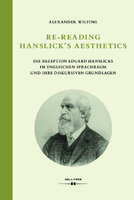Re-Reading Hanslick’s Aesthetics
Die Rezeption Eduard Hanslicks im englischen Sprachraum und ihre diskursiven Grundlagen
| dc.contributor.author | Wilfing, Alexander | |
| dc.contributor.editor | Lodes, Birgit | |
| dc.contributor.editor | Calella, Michele | |
| dc.date.accessioned | 2019-05-11 03:00:57 | |
| dc.date.accessioned | 2020-04-01T10:29:17Z | |
| dc.date.available | 2020-04-01T10:29:17Z | |
| dc.date.issued | 2019 | |
| dc.identifier | 1004916 | |
| dc.identifier | OCN: 1105806292 | en_US |
| dc.identifier.uri | http://library.oapen.org/handle/20.500.12657/25173 | |
| dc.description.abstract | This study examines the reception of Eduard Hanslick in Anglo-american discourse from its earliest instances in the 19th century up to analytical philosophy of music. This book thus analyzes primarily the discoursive conditions of Hanslick’s reception, which developed distinctly as part of different academic disciplines (history of art, musicology, philosophy of music). Moreover, this study explores the function Hanslick’s argument attained in modern debates of New Musicology and Anglo-american aesthetics, which cast new light upon the interpretation of Hanslick’s stances on the relation between emotion and music. | |
| dc.language | German | |
| dc.subject.other | Eduard Hanslick, formalism, aesthetics of music, music and emotion, theory of emotion, analytical philosophy, New Musicology, Immanuel Kant, Peter Kivy, Stephen Davies, Edmund Gurney, Adam Smith, Heinrich Schenker, John Sullivan Dwight, Clive Bell | |
| dc.subject.other | Eduard Hanslick, Formalismus, Musikästhetik, Musik und Gefühl, Emotionstheorie, analytische Philosophie, New Musicology, Immanuel Kant, Peter Kivy, Stephen Davies, Edmund Gurney, Adam Smith, Heinrich Schenker, John Sullivan Dwight, Clive Bell | |
| dc.title | Re-Reading Hanslick’s Aesthetics | |
| dc.title.alternative | Die Rezeption Eduard Hanslicks im englischen Sprachraum und ihre diskursiven Grundlagen | |
| dc.type | book | |
| oapen.abstract.otherlanguage | Diese Studie untersucht die Rezeption Eduard Hanslicks im englischen Sprachraum, von den Anfängen im 19. Jahrhundert bis hin zur analytischen Musikästhetik. Dabei lotet sie vor allem die diskursiven Bedingungen der Hanslick-Rezeption aus, die in den verschiedenen Fachrichtungen (Kunstgeschichte, Musikwissenschaft, Musikphilosophie) äußerst konträr sind. Sie fokussiert dabei besonders auf Hanslicks Funktion in aktuellen Debatten der New Musicology und der anglophonen Musikästhetik, die ein neues Licht auf die Interpretation von Hanslicks Argument zur Verbindung von Gefühl und Musik wirft. | |
| oapen.relation.isPublishedBy | ce271625-6bb4-4b64-9507-0d962a5d675e | |
| oapen.relation.isFundedBy | 26ae1657-c58f-4f1d-a392-585ee75c293e | |
| oapen.collection | Austrian Science Fund (FWF) | |
| oapen.pages | 433 | |
| oapen.grant.number | PUB 536 | |
| oapen.remark.public | 21-7-2020 - No DOI registered in CrossRef for ISBN 9783990125250 | |
| oapen.identifier.ocn | 1105806292 |

